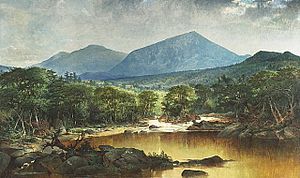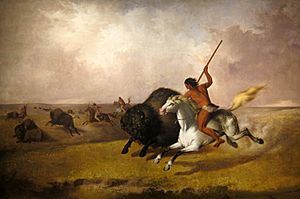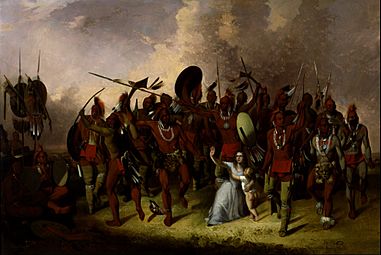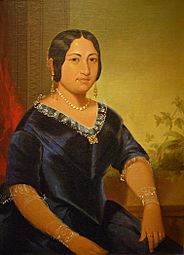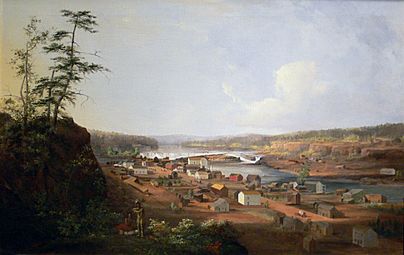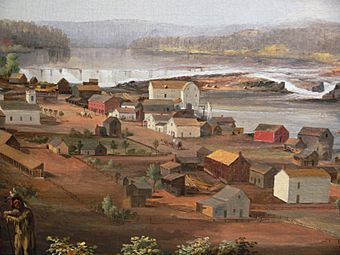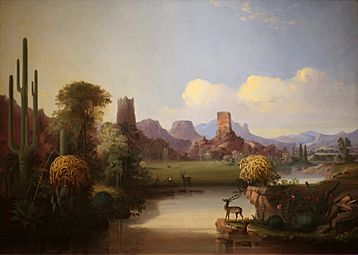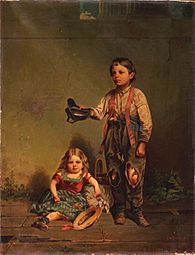John Mix Stanley facts for kids
Quick facts for kids
John Mix Stanley
|
|
|---|---|
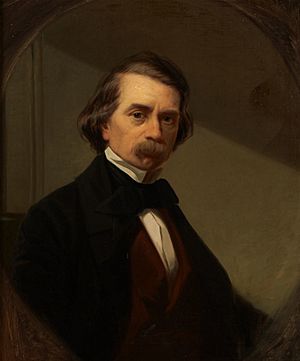
Oil on canvas self-portrait, c. 1860
|
|
| Born | January 17, 1814 Canandaigua, New York, U.S.
|
| Died | April 10, 1872 (aged 58) |
| Known for | Painting |
| Spouse(s) |
Alice C. English
(m. 1854) |
John Mix Stanley (January 17, 1814 – April 10, 1872) was an amazing artist and explorer from America. He was famous for painting beautiful landscapes and capturing the lives of Native American people and their tribes.
Born in New York, John started painting signs and portraits when he was young. In 1842, he began a big adventure, traveling to the American West to paint Native American life. He even showed 85 of his paintings in cities like Cincinnati and Louisville.
During the Mexican–American War, he joined an expedition to California. He painted scenes from the journey and also from the Oregon Territory. John continued his travels and painting in the West. In 1852, he had a huge exhibit of over 150 paintings at the Smithsonian Institution. Sadly, many of his paintings were lost in a fire at the Smithsonian in 1865. This made his work less known for a while. Today, his remaining paintings are very special and can be found in museums across the country.
Contents
Early Life and Learning to Paint
John Mix Stanley was born in Canandaigua, New York. He became an orphan when he was only 12 years old. At 14, he started working for a coach maker. But John taught himself how to paint. When he was 20, he moved to Detroit, which was a growing city in the Michigan Territory. There, he began working as a painter, traveling to different places.
Adventures and Art in the West
In 1832, John moved to Detroit, which was considered a frontier town back then. He painted signs and portraits. He also traveled to places like Fort Snelling, Galena, and Chicago. Later, he went back East and had a studio in Washington, D.C. for a short time.
In 1842, John went to the American Southwest specifically to paint Native Americans. He was probably inspired by another artist named George Catlin. John settled at Fort Gibson in what is now Oklahoma. This area was a meeting point for many different Native American nations.
In the summer of 1843, John went to a big meeting in Tahlequah. The Cherokee chief John Ross and the Republic of Texas called this meeting. About 10,000 Native Americans from 17 tribes came to talk about peace with Texas. John spent four weeks there, working hard to paint many portraits of individuals and tribal groups. He also spent time with Cherokee and Creek groups, painting their portraits.
Painting During the Mexican War
When the Mexican War started in 1846, John became a special artist for Colonel Stephen Watts Kearney's trip to California and the Oregon Territory. He created many sketches and paintings of the journey. After reaching San Francisco in 1847, he made more finished paintings. Some of his works were even turned into engravings. He traveled further north to Oregon and Washington to paint landscapes and different Native American tribes.
Art in Hawaii and the Smithsonian Exhibit
In 1848, John traveled to Hawaii. He spent almost a year there painting portraits of King Kamehameha III, his wife, and the royal family. After returning East, he organized a large exhibit of his Native American portraits and paintings in several cities, including New York.
In 1852, he had a huge exhibit called the Native American Gallery at the Smithsonian Institution in Washington, D.C. This exhibit got a lot of attention! John had painted 43 different tribes. His collection had almost 200 works and showed ten years of his travels. Another artist, Seth Eastman, said John's paintings were even better than George Catlin's. John hoped the US government would buy his collection, but they didn't.
Exploring the Northwest by Train
In 1853, John was chosen as the main artist for Isaac Stevens' expedition. This trip was to find a northern railroad route to the Pacific Coast. John loved this chance to travel and paint in the Northwest. They traveled from St. Paul, Minnesota, to the Washington Territory.
John saw large groups of Assiniboine people and visited a distant Blackfoot village. He also saw a huge hunting party of several hundred people, including families from the Pembina area near the Canada–US border. These were known as the Red River of the North hunters. They were mixed-race families who lived on the frontier and hunted bison. John painted many Northwest landmarks. These paintings were later made into prints for a report, which made John even more famous.
The Lost Panorama
After his return, John worked hard on a huge panorama (a very long painting) of western scenes from the northern survey route. His exhibit of 42 scenes opened in Washington, D.C., on September 1, 1854. It came with a 23-page booklet describing everything. People said it took two hours to see the whole panorama! This exhibit was the last of John's big western adventures and was highly praised. It was shown in Baltimore, New York, and London. Sadly, this amazing panorama later disappeared, and no one knows where it is today.
John returned to Detroit in 1864 and set up his art studio. He stayed in Detroit for the rest of his life. He helped start a group that later became the Detroit Institute of Arts. He also helped create the National Gallery of Art in Washington, D.C. He had hoped his Native American gallery would be the start of its collection. But, as mentioned before, over 200 of his paintings, maps, and other documents were destroyed in the Smithsonian fire of 1865.
The Indian Atlas and Maps
John wanted to create an atlas (a book of maps and information) about the American Indians. But after most of his paintings were lost in the 1865 fire, he never finished it. Only a few pages still exist. These pages include his introduction and descriptions of three pictures: a Plains Indian camp, a Chinook burial ground, and a buffalo hunt. John described what the pictures showed and shared historical and cultural facts about each tribe or area.
As an artist and explorer, John traveled a lot, especially in the American West. He made a large collection of maps. These maps were also kept at the Smithsonian Institution and were destroyed in the 1865 fire.
Paintings of Native Americans
John Mix Stanley cared deeply about the American Indians. The Smithsonian had a large and successful exhibit of his paintings in 1852. However, the government never bought them. More than 200 of his works, along with many of his maps and other documents, were destroyed in the Smithsonian fire of 1865. This big loss likely made his work less known in American art history for a long time.
His surviving paintings are now kept in national museums and many regional museums: National Museums:
- Corcoran Gallery of Art (Washington, D.C.)
- Metropolitan Museum of Art (New York City)
- National Gallery of Art (Washington, D.C.)
- National Portrait Gallery (Washington, D.C.)
- Smithsonian American Art Museum (Washington, D.C.)
Regional Museums:
- Amon Carter Museum (Fort Worth, Texas)
- Arizona State University Art Museum (Tempe, Arizona)
- Buffalo History Museum (Buffalo, NY)
- Buffalo Bill Historical Center (Cody, Wyoming)
- Denver Art Museum
- Detroit Institute of Arts
- Eiteljorg Museum of American Indians & Western Art (Indianapolis, Indiana)
- Galena Historical Museum (Galena, Illinois)
- Gilcrease Museum (Tulsa, Oklahoma)
- Honolulu Museum of Art
- Joslyn Art Museum (Omaha, Nebraska)
- National Museum of Wildlife Art (Jackson Hole, Wyoming)
- Phoenix Art Museum (Phoenix, Arizona)
- Rockwell Museum (Corning, New York)
- Stark Museum of Art (Orange, Texas)
- University of Arizona Museum of Art (Tucson, Arizona)
- University of Michigan Museum of Art (Ann Arbor, Michigan)
- Westervelt Warner Museum of American Art (Tuscaloosa, Alabama)
- William L. Clements Library (University of Michigan, Ann Arbor, Michigan)
- Worcester Art Museum (Worcester, Maine)
- Yale University Art Gallery (New Haven, Connecticut)
Recent Exhibitions
John Stanley's art was celebrated in an exhibit called "Painted Journeys-The Art of John Mix Stanley." It opened in June 2015 at the Buffalo Bill Center of the West in Cody, Wyoming. The exhibit featured over 60 of Stanley's works. These were from the 227 paintings known to still exist today. The exhibit later traveled to the Gilcrease Museum in Tulsa, Oklahoma, and the Tacoma Art Museum in Tacoma, Washington.
Family Life
John Stanley married Alice C. English in 1854. He was 40 years old and had mostly finished his travels in the West. They had five children together, but sadly, two of them passed away as babies.
One of their sons, L. C. Stanley, wrote a book about his father called "John Mix Stanley, Artist-Explorer." John's granddaughter, Alice Caroline Stanley, also became a painter. She was married to Dean Acheson, who was a very important government official called the Secretary of State.
Gallery


